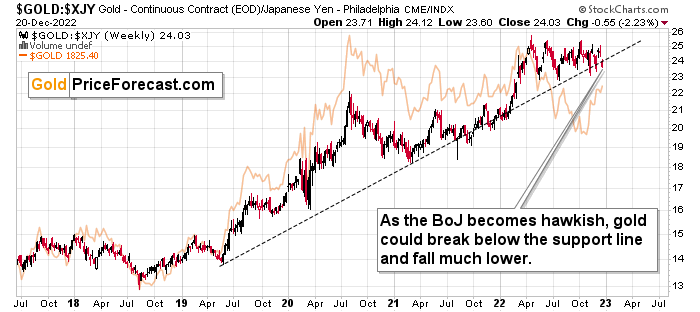Gold, Yen, and Junior Miners’ Insightful Reaction
The gold price in the USD moved higher yesterday, but in terms of the yen, it collapsed. Which of the moves shows the real direction?
The gold price in the USD moved higher yesterday, but in terms of the yen, it collapsed. Which of the moves shows the real direction?
The one featuring gold price in the Japanese yen.

As you can see on the above chart, it moved below the rising long-term support line once again, and each time it previously tried to break below it, it moved higher once again. However, this time is already different because of the fundamental shift in the Bank of Japan’s strategy. We will discuss it more thoroughly in the following part of today’s analysis, and for now, I would like to once again discuss why the action in the gold-USD Index link is currently different than what usually happens.
It might all seem complex until one focuses on what really drove the recent price movement.
It was not about what happened in the USA – it was about what happened in Japan.
It was not about the US currency’s weakness. It was about the strength of Japan’s currency.
Gold can be viewed as a currency, and in fact, it is priced as such. Gold’s value didn’t really increase yesterday – it was the fact that other exchange rates changed materially that impacted what we saw from the USD point of view.
So, once again, gold didn’t how relative strength to the U.S. dollar’s weakness because it wasn’t the U.S. dollar that was weak yesterday. It was the yen that was strong, and it made the currency exchange rate between the USD and yen move so much that it affected gold’s price in the USD.
It’s not a game-changer. It’s just a temporary price noise.
The above might be confusing, and indeed, many market participants are likely to react to the USD Index’s movement based on its face value. But that’s simply incorrect, and people are likely to come to their senses relatively soon (it’s not that complex, either).
If this is still perplexing, I’ll quote what I wrote about it yesterday:
It’s easier to understand the implication based on a counter-example. Remember when all the monetary authorities around the world were getting more and more dovish and they kept printing more and more money? That was bullish for gold, right?
Ok, so now what we see is the opposite. The monetary authorities around the world are getting more and more hawkish, and the Bank of Japan appears to be finally joining the hawkish party, which is bearish for gold.
This remains true despite any short-term price movements caused by individual currency exchange rate changes. So, even if the yen continues to strengthen relative to the dollar for some time, gold might not be willing to react to it for much longer.
Why? Because in the short-term, markets are particularly emotional. “OMG, USDX fell, let’s buy gold!” can dominate traders’ way of feeling/thinking (on a side note, “feenking” could be a new verb to describe the situation when one thinks that they are thinking about something, but actually they are just rationalizing their feelings).
Then, as the traders have some time to think about what’s really happening, they could sell gold as it becomes less and less appealing, given that fiat money can (at least for now…) provide more interest payments.
Actually, the USD Index might not be willing to decline more at this time anyway. Why? Strong technical support.

As you may recall, the USD Index is trading close to its 2016 and 2020 highs. It’s not below the lower of those in terms of the daily closing prices, so it’s too early to be talking about a breakdown, let alone a confirmed one. Still, the proximity of those highs (also on an intraday basis) is likely to be enough to trigger a rebound and a rally soon.
And while the USD Index is testing its recent lows, are junior mining stocks testing their recent highs?

No!
Junior miners (GDXJ ETF serves as proxy for them) corrected approximately half of their recent downswing.
It’s clear that gold miners don’t want to rally here. Their corrective Sep.-Dec. upswing is most likely over, and thus they are now likely to react weakly to factors that would make them rally (like weaker USD Index values) and strongly to factors that would make them decline (like stronger USD Index values, or weaker stock market valuations).
Technically, please note that the GDXJ moved below its accelerating trend channel (marked with orange lines), and it’s now simply verifying this breakdown.
So, all in all, the precious metals market is likely to move lower in the following weeks, as the dust around the recent Bank of Japan’s action settles.
= = = = =
Before summarizing, I have great news for you. If you’d like to get a LIVE follow-up on the above analysis (with the possibility to ask me questions) and see me talking about the top 3 gold trading techniques that I found to be working over and over again, then you’ll have a chance to get the above free of charge LIVE on Wednesday, Dec. 21 at 10 AM EST (4 PM CET) on our Youtube, Facebook, Twitter, and LinkedIn channels. If the above is not displayed as a link, just Google “Golden Meadow Radomski” and you’ll definitely find it. I hope to see you very soon :) And the easiest way to sign up is right here.
= = = = =
To summarize, despite this week’s upswing in gold and silver (and a much smaller one in mining stocks), the outlook for the following weeks doesn’t look bullish at all. Conversely, as monetary authorities around the world get more hawkish, gold, silver, and mining stocks are likely to move lower.
Przemysław K. Radomski, CFA
Founder, CEO